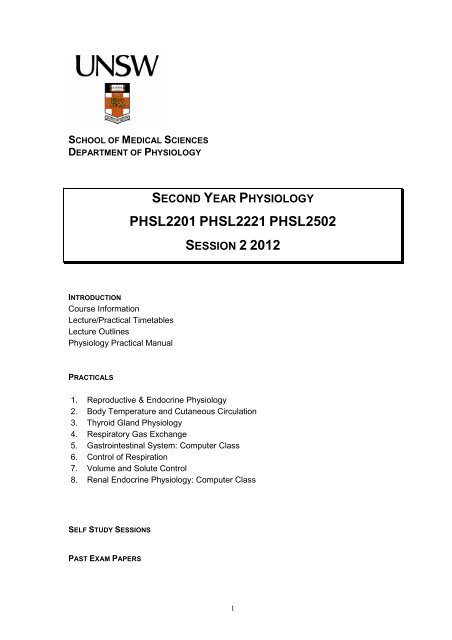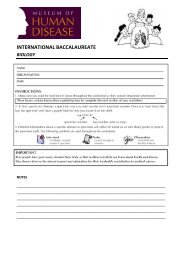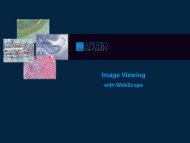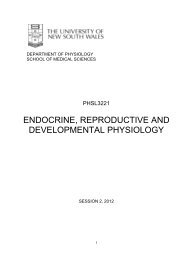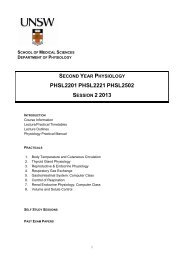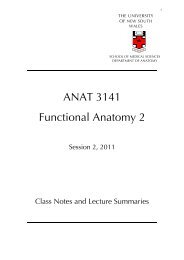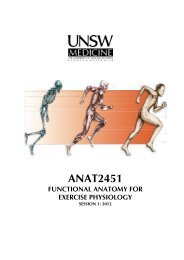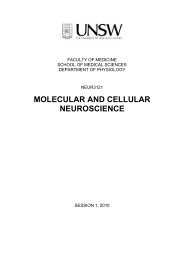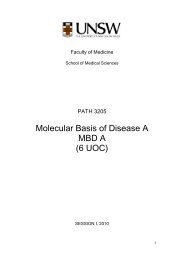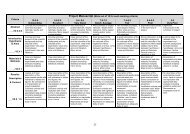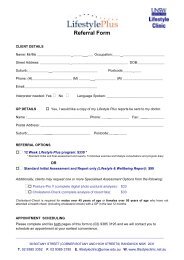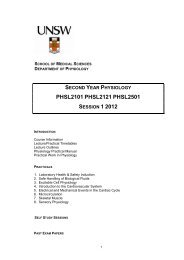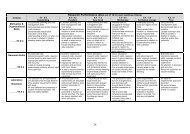PHSL2201 PHSL2221 PHSL2502 - School of Medical Sciences
PHSL2201 PHSL2221 PHSL2502 - School of Medical Sciences
PHSL2201 PHSL2221 PHSL2502 - School of Medical Sciences
Create successful ePaper yourself
Turn your PDF publications into a flip-book with our unique Google optimized e-Paper software.
SCHOOL OF MEDICAL SCIENCES<br />
DEPARTMENT OF PHYSIOLOGY<br />
SECOND YEAR PHYSIOLOGY<br />
<strong>PHSL2201</strong> <strong>PHSL2221</strong> <strong>PHSL2502</strong><br />
SESSION 2 2012<br />
INTRODUCTION<br />
Course Information<br />
Lecture/Practical Timetables<br />
Lecture Outlines<br />
Physiology Practical Manual<br />
PRACTICALS<br />
1. Reproductive & Endocrine Physiology<br />
2. Body Temperature and Cutaneous Circulation<br />
3. Thyroid Gland Physiology<br />
4. Respiratory Gas Exchange<br />
5. Gastrointestinal System: Computer Class<br />
6. Control <strong>of</strong> Respiration<br />
7. Volume and Solute Control<br />
8. Renal Endocrine Physiology: Computer Class<br />
SELF STUDY SESSIONS<br />
PAST EXAM PAPERS<br />
1
COURSE INFORMATION<br />
3
EXAMINER AND COURSE CO-ORDINATOR<br />
Co-ordinator: Dr. Lesley Ulman Room 210B (ph: 9385 3601)<br />
L.Ulman@unsw.edu.au<br />
If you need to consult with the course convenor, appointments can be set up through<br />
email.<br />
LECTURERS IN THIS COURSE<br />
Dr K. Gibson K.Gibson@unsw.edu.au<br />
Dr T. Lewis T.Lewis@unsw.edu.au<br />
Dr E. Han<br />
e.han@unsw.edu.au<br />
Dr S.Sandow shaun.sandow@unsw.edu.au<br />
Dr P. Bertrand P.Bertrand@unsw.edu.au<br />
Pr<strong>of</strong> M. Morris M.Morris@unsw.edu.au<br />
If you require to consult with any <strong>of</strong> these staff, appointments can be made via email.<br />
OBJECTIVES OF THE COURSE<br />
This course is <strong>of</strong>fered to second year students and follows on from the first session<br />
course. The major aims <strong>of</strong> this course are to provide students with a basic<br />
understanding <strong>of</strong> the fundamental processes and mechanisms that serve and control the<br />
various functions <strong>of</strong> the body. It should be noted that, although introductory, this course<br />
in Human Physiology is comprehensive in scope. Areas treated in detail include<br />
Endocrine Physiology, Reproductive Physiology, Respiration, Kidney & Body Fluids and<br />
Gastrointestinal Physiology.<br />
It should also be noted that, where appropriate, subject areas are treated quantitatively<br />
as well as qualitatively, an approach that requires students to have at least a basic<br />
knowledge <strong>of</strong> mathematics and chemistry.<br />
COURSE STRUCTURE<br />
This is a 6 unit <strong>of</strong> credit course. There are 2-3, one hour lectures per week (Tue 9-10,<br />
Wed 9-10 and Fri 3-4). Lectures will provide you with the concepts and theory essential<br />
for understanding the fundamental processes <strong>of</strong> body function. The Fri 3-4 slot on some<br />
occasions will be used for a tutorial which aids in better understanding <strong>of</strong> lecture<br />
material. The practical classes are a major component <strong>of</strong> the course and comprise a<br />
weekly 3 hour laboratory session during which students typically work in small groups <strong>of</strong><br />
about 5 and carry out the laboratory exercises outlined in this practical manual. These<br />
sessions will give an insight into how knowledge is obtained, and how the results <strong>of</strong><br />
experiments depend not only on what we measure but how we measure it. Some <strong>of</strong><br />
these sessions will be computer based, rather than <strong>of</strong> a practical nature and some will be<br />
self directed learning sessions based on the interactive physiology website.<br />
APPROACH TO LEARNING AND TEACHING<br />
Although the primary source <strong>of</strong> information for this course is the lecture material,<br />
effective learning can be enhanced through self directed use <strong>of</strong> other resources such as<br />
textbooks and UNSW Blackboard. Your practical classes will be directly related to the<br />
lectures and it is essential to prepare for practical classes before attendance. It is up to<br />
you to ensure you perform well in each part <strong>of</strong> the course; preparing for classes; studying<br />
for quizzes and exams and seeking assistance to clarify your understanding. Past exam<br />
questions are provided to assist you in preparing for examinations.<br />
5
UNSW LEARNING OUTCOMES<br />
UNSW aims to provide an environment that fosters students achieving the following<br />
generic graduate attributes:<br />
1. the skills involved in scholarly enquiry<br />
2. an in-depth engagement with the relevant disciplinary knowledge in its interdisciplinary<br />
context<br />
3. the capacity for analytical and critical thinking and for creative problem-solving<br />
4. the ability to engage in independent and reflective learning<br />
5. information literacy - the skills to appropriately locate, evaluate and use relevant<br />
information<br />
6. the capacity for enterprise, initiative and creativity<br />
7. an appreciation <strong>of</strong>, and respect for, diversity<br />
8. a capacity to contribute to, and work within, the international community<br />
9. the skills required for collaborative and multidisciplinary work<br />
10. an appreciation <strong>of</strong>, and a responsiveness to, change<br />
11. a respect for ethical practice and social responsibility<br />
12. the skills <strong>of</strong> effective communication.<br />
Not every course addresses all these attributes evenly. In second year physiology,<br />
attributes 1-4 are most relevant. The following are more specific learning outcomes for<br />
this course designed to incorporate some <strong>of</strong> the generic graduate attributes listed above<br />
in a more context specific form.<br />
SPECIFIC LEARNING OUTCOMES<br />
By the end <strong>of</strong> this course students are expected to have gained a basic understanding <strong>of</strong><br />
the fundamental processes and mechanisms that serve and control the various functions<br />
<strong>of</strong> the body. More specifically students should have a basic knowledge <strong>of</strong><br />
Temperature Regulation<br />
- normal body temperature and how it is regulated<br />
Endocrine Physiology<br />
- the mechanisms <strong>of</strong> hormone action<br />
- simple feedback-loop endocrine systems<br />
- hypothalamus and pituitary gland<br />
- thyroid gland<br />
- adrenal gland<br />
Reproduction<br />
- male reproductive system<br />
- female reproductive system<br />
- pregnancy<br />
Respiratory System<br />
- anatomical features and their physiological significance<br />
- ventilation<br />
- oxygen transport<br />
- carbon dioxide transport and blood buffering<br />
- respiratory mechanics<br />
- control <strong>of</strong> respiration<br />
- respiration and exercise<br />
6
Gastrointestinal System<br />
- overview <strong>of</strong> the gastrointestinal tract and the glands associated with digestion<br />
- stomach – structure and digestion<br />
- release <strong>of</strong> pancreatic enzymes and bile salts from the gallbladder and liver<br />
- small intestine – structure and role in digestion and absorption<br />
- regulation and control <strong>of</strong> food intake<br />
- control <strong>of</strong> gastro-intestinal tract motility<br />
- large intestine – structure and function<br />
- appetite control<br />
Kidney and Body Fluids<br />
- body fluids<br />
- renal blood flow and glomerular filtration<br />
- reabsorption and secretion<br />
- evaluation <strong>of</strong> renal function<br />
- tubular structure and function along the nephron<br />
- renal water homeostasis<br />
- urinary concentrating mechanisms<br />
- renal sodium and potassium balance<br />
- renal acid-base balance<br />
ASSESSMENT<br />
Mid-session Theory Exam (50 minutes duration)<br />
The mid-session exam will be held on Wednesday 29 th August 2012 and will<br />
consist <strong>of</strong> the following:<br />
• 15 multiple choice questions on material covered in all Temperature<br />
Regulation, Endocrine, Reproduction and Respiration lectures and<br />
tutorials (25 minutes).<br />
• Two short answer questions; one on Endocrine and one on Respiration<br />
(25 minutes in total).<br />
End <strong>of</strong> Session Exam (2 hours duration)<br />
The end <strong>of</strong> session exam will consist <strong>of</strong> the following:<br />
• 15 multiple choice questions on all Gastrointestinal Tract and Kidney and<br />
Body Fluids lectures and tutorials.<br />
• Three short answer questions (approximately 13 minutes each); one on<br />
Reproduction, one on Gastrointestinal Tract and one on Kidney and Body<br />
Fluids.<br />
• 30 multiple choice questions on material pertaining to the practical classes<br />
in Session 2. You will not be able to take your prac books into the exam.<br />
Online Feedback Quizzes<br />
There will be a series <strong>of</strong> 5 online feedback quizzes throughout the session<br />
covering each topic. These quizzes will be made available online a few days after<br />
the conclusion <strong>of</strong> each lecture series. These quizzes are to be used as a study<br />
aid and you will receive immediate detailed feedback after submitting your<br />
answers. The quizzes are to be attempted in your own time and each quiz will be<br />
accessible for a period <strong>of</strong> one week. You may attempt these quizzes as many<br />
times as you wish within this period. You will receive 2% towards your overall<br />
grade for each quiz provided you achieve a minimum score <strong>of</strong> 90% for the quiz.<br />
%Total<br />
Marks<br />
30%<br />
50%<br />
10%<br />
7
ALL MULTIPLE CHOICE QUESTIONS EXAMINING LECTURE AND TUTORIAL MATERIAL IN<br />
THE MIDSESSION AND END OF SESSION EXAM WILL BE DRAWN FROM THE BANK OF<br />
QUESTIONS USED IN THE ONLINE QUIZZES THROUGHOUT THE SESSION.<br />
PLEASE NOTE THAT THIS DOES NOT APPLY TO MULTIPLE CHOICE QUESTIONS BASED<br />
ON PRACTICAL CLASS MATERIAL – THESE QUESTIONS WILL NOT HAVE BEEN SEEN BY<br />
YOU PRIOR TO THE END OF SESSION EXAM.<br />
A timetable <strong>of</strong> online quiz dates and periods <strong>of</strong> accessibility will be posted up on<br />
blackboard early in the session.<br />
Please note that online feedback assessments are intended to motivate<br />
your study, provide feedback on your progress and to stimulate your<br />
learning. There is published data which demonstrates that students who<br />
participate in online feedback assessments perform significantly better<br />
than their peers in end <strong>of</strong> course examinations.<br />
When attempting each online feedback assessment, please complete it under<br />
exam conditions (by exam conditions, we mean you should do it by yourself, don't<br />
look up the answers as you do it, and commit yourself to an answer), at least the<br />
first time you attempt it. This will provide the most realistic appraisal <strong>of</strong> your<br />
performance.<br />
Give yourself plenty <strong>of</strong> time, and attempt the feedback assessment in a place<br />
where you won't be interrupted. If you are attempting to simulate exam conditions,<br />
you should allow up to 2 minutes per question.<br />
Write down items that you are not sure about as you go. Even if you get the<br />
question right you should still read further about anything that is unclear to you.<br />
If you don't agree with, or can't understand the reason for an answer, ask the<br />
appropriate member <strong>of</strong> academic staff. If you are not sure who that is, ask your<br />
colleagues or the course convenor.<br />
Technical problems regarding access to the assessment should be directed to the<br />
course convenor.<br />
Practical Quizzes<br />
Conducted immediately before some <strong>of</strong> the practical classes. These quizzes will<br />
contain a mixture <strong>of</strong> questions on that day’s work and on the previous supervised<br />
practical class that you did. Please note that the self-directed learning classes on<br />
GIT and Renal Endocrine are not supervised practicals and questions on these<br />
practicals will not be included in the practical quizzes, however these practicals<br />
will be examined in the end <strong>of</strong> session exam. A minimum <strong>of</strong> three quizzes will be<br />
given throughout the session and your mark for this component will be an<br />
average <strong>of</strong> all <strong>of</strong> the quizzes you are given.<br />
10%<br />
TEXTBOOK<br />
PRINCIPLES OF HUMAN PHYSIOLOGY by Cindy L. Stanfield, Benjamin Cummings, 4 th<br />
edition, 2011. Books are available from the UNSW bookshop.<br />
This textbook comes with an Interactive Physiology CD. Several self study sessions<br />
based on this Interactive Physiology CD have been designed to allow you to revise the<br />
8
lecture material in your own time. There is no set time allocated for these suggested self<br />
study sessions – you are encouraged to work through these sessions in your own time<br />
as a supplement to lectures and tutorials. Please refer to the end <strong>of</strong> this practical manual<br />
for further details on the self study sessions.<br />
GENERAL INFORMATION<br />
The Department <strong>of</strong> Physiology is part <strong>of</strong> the <strong>School</strong> <strong>of</strong> <strong>Medical</strong> <strong>Sciences</strong> and is within the<br />
Faculty <strong>of</strong> Medicine. It is located on the 2 nd and 3 rd floors <strong>of</strong> the Wallace Wurth building.<br />
General inquiries can be made to the school teaching administrator Carmen Robinson<br />
(9385 2464, carmen.robinson@unsw.edu.au) who is located on the Ground Floor <strong>of</strong> the<br />
Biological <strong>Sciences</strong> Building room G27.<br />
Pr<strong>of</strong>essor Gary Housley is Head <strong>of</strong> Department and appointments to see him may be<br />
made through email (G.Housley@unsw.edu.au).<br />
There is an honours program conducted by the <strong>School</strong>. The Honours program is coordinated<br />
by Dr Patsie Polly (patsie.polly@unsw.edu.au). Any students considering an<br />
Honours year should discuss the requirements with the co-ordinator. Outstanding<br />
students may be considered for scholarships <strong>of</strong>fered by the University and <strong>School</strong> and<br />
these are <strong>of</strong>fered annually.<br />
Postgraduate research degrees<br />
The Department <strong>of</strong> Physiology <strong>of</strong>fers students the opportunity to undertake a Doctorate<br />
(Ph.D). For further information contact the co-ordinator, Dr Pascal Carrive<br />
(P.Carrive@unsw.edu.au).<br />
Departmental Vacation Scholarships: The Department <strong>of</strong> Physiology supports several<br />
summer vacation scholarships each year to enable good students to undertake short<br />
research projects within the department. For further details contact the Administrative<br />
Officer.<br />
ATTENDANCE REQUIREMENTS<br />
Attendance at practical classes/demonstrations is compulsory FOR ALL<br />
STUDENTS, and must be recorded in the class roll ON THE DAY OF THE CLASS.<br />
It is your responsibility to ensure that the demonstrator records your attendance<br />
and no discussions will be entered into after the completion <strong>of</strong> the class.<br />
Satisfactory completion <strong>of</strong> the work set for each class is essential and IS A REQUIREMENT<br />
FOR PASSING PHYSIOLOGY. Non-attendance for other than documented medical or other<br />
serious reasons may make you ineligible to successfully complete this course. At the<br />
very least you may be required to pass an additional oral examination on the practical<br />
classes, as well as undertaking the normal practical exam and quizzes. Students who<br />
miss practical classes due to illness or for other reasons must submit a medical<br />
certificate to Dr. Lesley Ulman (Rm 210B) WITHIN 7 DAYS (practical classes only) <strong>of</strong><br />
missing a class. If received after this time, no consideration will be given and the student<br />
will be marked absent from that class. The following details must be attached:<br />
Name, Student number, Course number, Group number, Date <strong>of</strong> the class, Name<br />
<strong>of</strong> class missed.<br />
The practical component <strong>of</strong> the final exam is compulsory FOR ALL STUDENTS.<br />
PLEASE NOTE that missing any examination requires lodging a medical certificate with<br />
Student Central within 3 DAYS (refer to UNSW Student Gateway @<br />
www.student.unsw.edu.au for further details).<br />
9
OFFICIAL COMMUNICATION BY EMAIL<br />
All students in courses <strong>PHSL2201</strong>, 2221 and 2502 are advised that e-mail is the <strong>of</strong>ficial<br />
means by which the <strong>School</strong> <strong>of</strong> <strong>Medical</strong> <strong>Sciences</strong> at UNSW will communicate with you.<br />
All e-mail messages will be sent to your <strong>of</strong>ficial UNSW e-mail address (e.g.,<br />
z1234567@student.unsw.edu.au) and, if you do not wish to use the University e-mail<br />
system, you MUST arrange for your <strong>of</strong>ficial mail to be forwarded to your chosen address.<br />
The University recommends that you check your mail at least every other day. Facilities<br />
for checking e-mail are available in the <strong>School</strong> <strong>of</strong> <strong>Medical</strong> <strong>Sciences</strong> and in the University<br />
library. Further information and assistance is available from DIS-Connect, ph. 9385<br />
1777. Free e-mail courses are run by the UNSW Library.<br />
NOTICEBOARDS<br />
Noticeboards for this course can be found on the 2 nd floor <strong>of</strong> the Wallace Wurth building.<br />
Current timetables and information relevant to you will be displayed here. It is your<br />
responsibility to check these regularly.<br />
All lectures are taped by the ilecture system and can be accessed via UNSW<br />
Blackboard. Textbooks and some reference materials are available through open<br />
reserve.<br />
TEACHING RESOURCES IN PHYSIOLOGY<br />
The Department <strong>of</strong> Physiology has chosen to use the UNSW Blackboard Learning<br />
platform to provide teaching material for all <strong>of</strong> its courses. You can make use <strong>of</strong> ilecture<br />
recordings (audio only) taken <strong>of</strong> the lectures which are available on Blackboard Learning.<br />
Lecture notes and various learning materials will also be made available on BBL either<br />
before or shortly after the lecture.<br />
For BBL direct access point your browser to:<br />
http://lms-blackboard.telt.unsw.edu.au/webapps/portal/frameset.jsp<br />
or go to the <strong>School</strong>'s home page at:<br />
http://medicalsciences.med.unsw.edu.au/, then select "Current Students" from the menu<br />
bar and click on UNSW Blackboard Learning, under "Quicklinks" in the left column. You<br />
will need to enter your Zpass credentials (zStudentNo and Zpass).You should have<br />
access to the available individual course links if you are properly enrolled. Please note<br />
that not every course you have enrolled in has chosen to use UNSW Blackboard<br />
Learning as a learning supplement.<br />
System Requirement for BBL:<br />
UNSW Blackboard supports the following web browsers for Windows XP or VISTA.<br />
• Internet Explorer (IE) version 7 or 9<br />
• Firefox 3.0x (must run version 3.0.3 and above)<br />
UNSW Blackboard supports the following web browsers for Mac 10.4 or 10.5 (Mac OS<br />
10.3 is not supported)<br />
• Firefox 3.0.x(must run version 3.0.3 and above)<br />
• Safari 2 or 3<br />
Firefox is the preferred browser in both PC & Mac environment.<br />
10
HANDWRITING<br />
Students whose writing is difficult to understand will disadvantage themselves in their<br />
written assessment. Make every effort to write clearly and legibly. Do not use your own<br />
abbreviations.<br />
APPLICATIONS FOR SPECIAL CONSIDERATION FOR MISSED ASSESSMENTS /<br />
EXAMS<br />
Please note the following Statement regarding Special Consideration.<br />
If you believe that your performance in a course, either during session or in an<br />
examination, has been adversely affected by sickness or for any other reason, you<br />
should notify the Registrar and ask for special consideration in the determination <strong>of</strong> your<br />
results. Such requests should be made as soon as practicable after the problem occurs.<br />
Special consideration sought more than three days after an examination in a<br />
course WILL NOT be accepted except in TRULY exceptional circumstances.<br />
When submitting a request for special consideration you should provide all possible<br />
supporting evidence (eg medical certificates) together with your student number and<br />
enrolment details. Consideration request forms are available from Student Central in the<br />
Chancellery.<br />
Students who miss an assessment must submit an application for consideration to<br />
Student Central and must also contact the course convenor immediately. If you miss an<br />
assessment and have applied for Special Consideration, this will be taken into account<br />
when your final grade is determined. You should note that marks derived from completed<br />
assessment tasks may be used as the primary basis for determining an overall mark e.g.<br />
by extrapolating from your percentile rank on those tasks. Where appropriate,<br />
supplementary examination may be <strong>of</strong>fered, but only when warranted by the<br />
circumstances.<br />
Normally, if you miss an exam (without medical reasons) you will be given an absent fail.<br />
If you arrive late for an exam no time extension will be granted. It is your responsibility to<br />
check timetables and ensure that you arrive with sufficient time.<br />
Please refer to https://my.unsw.edu.au/student/atoz/SpecialConsideration.html for further<br />
details regarding special consideration.<br />
REPEATING STUDENTS<br />
Practical class exemptions may be granted to repeat students but students must check<br />
with the course co-ordinator whether they have exemption prior to their first practical<br />
class. All students must be familiar with the material covered in the practical classes. All<br />
students must do the practical component <strong>of</strong> the final exam.<br />
CONTINUAL COURSE IMPROVEMENT<br />
Periodically student evaluative feedback on the course is gathered, using among other<br />
means, UNSW's Course and Teaching Evaluation and Improvement (CATEI) Process.<br />
Student feedback is taken seriously, and continual improvements are made to the course<br />
based in part on such feedback. Significant changes to the course will be communicated<br />
to subsequent cohorts <strong>of</strong> students taking the course.<br />
11
STUDENT SUPPORT SERVICES<br />
Those students who have a disability that requires some adjustment in their teaching or<br />
learning environment are encouraged to discuss their study needs with the course coordinator<br />
prior to, or at the commencement <strong>of</strong>, their course, or with the Equity Officer<br />
(Disability) in the Equity and Diversity Unit (9385 4734 or<br />
www.equity.unsw.edu.au/disabil.html). Issues to be discussed may include access to<br />
materials, signers or note-takers, the provision <strong>of</strong> services and additional exam and<br />
assessment arrangements. Early notification is essential to enable any necessary<br />
adjustments to be made. Information on designing courses and course outlines that take<br />
into account the needs <strong>of</strong> students with disabilities can be found at:<br />
www.secretariat.unsw.edu.au/acboardcom/minutes/coe/disabilityguidelines.pdf<br />
STUDENT RIGHTS AND RESPONSIBILITIES<br />
Refer to UNSW Student Gateway @ www.student.unsw.edu.au<br />
ACADEMIC HONESTY AND PLAGIARISM<br />
The <strong>School</strong> <strong>of</strong> <strong>Medical</strong> <strong>Sciences</strong> will not tolerate plagiarism in submitted written work.<br />
The University regards this as academic misconduct and imposes severe penalties.<br />
Evidence <strong>of</strong> plagiarism in submitted assignments, etc. will be thoroughly investigated and<br />
may be penalised by the award <strong>of</strong> a score <strong>of</strong> zero for the assessable work. Flagrant<br />
plagiarism will be directly referred to the Division <strong>of</strong> the Registrar for disciplinary action<br />
under UNSW rules.<br />
Plagiarism is the presentation <strong>of</strong> the thoughts or work <strong>of</strong> another as one’s own.*<br />
Examples include:<br />
• direct duplication <strong>of</strong> the thoughts or work <strong>of</strong> another, including by copying work,<br />
or knowingly permitting it to be copied. This includes copying material, ideas or<br />
concepts from a book, article, report or other written document (whether<br />
published or unpublished), composition, artwork, design, drawing, circuitry,<br />
computer program or s<strong>of</strong>tware, web site, Internet, other electronic resource, or<br />
another person’s assignment without appropriate acknowledgement;<br />
• paraphrasing another person’s work with very minor changes keeping the<br />
meaning, form and/or progression <strong>of</strong> ideas <strong>of</strong> the original;<br />
• piecing together sections <strong>of</strong> the work <strong>of</strong> others into a new whole;<br />
• presenting an assessment item as independent work when it has been produced<br />
in whole or part in collusion with other people, for example, another student or a<br />
tutor;<br />
• claiming credit for a proportion <strong>of</strong> work contributed to a group assessment item<br />
that is greater than that actually contributed.†<br />
Submitting an assessment item that has already been submitted for academic credit<br />
elsewhere may also be considered plagiarism.<br />
Other examples <strong>of</strong> plagiarism include:<br />
• quotation without the use <strong>of</strong> quotation marks. It is a serious breach <strong>of</strong> these rules<br />
to quote another's work without using quotation marks, even if one then refers to<br />
the quoted source. The fact that it is quoted must be acknowledged in your work.<br />
12
• unacknowledged use <strong>of</strong> information or ideas, unless such information or ideas<br />
are commonplace.<br />
• citing sources (e.g. texts) which you have not read, without acknowledging the<br />
'secondary' source from which knowledge <strong>of</strong> them has been obtained.<br />
Appropriate citation <strong>of</strong> sources therefore includes surrounding any directly quoted text<br />
with quotation marks, with block indentation for larger segments <strong>of</strong> directly-quoted text.<br />
The preferred format for citation <strong>of</strong> references is an author-date format with an<br />
alphabetically arranged bibliography at the end <strong>of</strong> the assignment. Note that merely<br />
citing textbooks or website URLs is unlikely to yield a bibliography <strong>of</strong> satisfactory<br />
standard. The internet should be avoided as a primary source <strong>of</strong> information. Inclusion<br />
<strong>of</strong> appropriate journal articles, both primary research publications and reviews, is usually<br />
expected.<br />
The inclusion <strong>of</strong> the thoughts or work <strong>of</strong> another with attribution appropriate to the<br />
academic discipline does not amount to plagiarism.<br />
Students are reminded <strong>of</strong> their Rights and Responsibilities in respect <strong>of</strong> plagiarism, as<br />
set out in the University Undergraduate and Postgraduate Handbooks, and are<br />
encouraged to seek advice from academic staff whenever necessary to ensure they<br />
avoid plagiarism in all its forms.<br />
The Learning Centre website is the central University online resource for staff and<br />
student information on plagiarism and academic honesty. It can be located at:<br />
www.lc.unsw.edu.au/plagiarism<br />
The Learning Centre also provides substantial educational written materials, workshops,<br />
and tutorials to aid students, for example, in:<br />
• correct referencing practices;<br />
• paraphrasing, summarising, essay writing, and time management;<br />
• appropriate use <strong>of</strong>, and attribution for, a range <strong>of</strong> materials including text, images,<br />
formulae and concepts.<br />
Individual assistance is available on request from The Learning Centre.<br />
Students are also reminded that careful time management is an important part <strong>of</strong> study<br />
and one <strong>of</strong> the identified causes <strong>of</strong> plagiarism is poor time management. Students<br />
should allow sufficient time for research, drafting, and the proper referencing <strong>of</strong> sources<br />
in preparing all assessment items.<br />
* Based on that proposed to the University <strong>of</strong> Newcastle by the St James Ethics Centre. Used with kind permission from<br />
the University <strong>of</strong> Newcastle.<br />
† Adapted with kind permission from the University <strong>of</strong> Melbourne.<br />
GUIDELINES ON EXTRA-CURRICULAR ACTIVITIES AFFECTING ATTENDANCE<br />
Students should refer to the following website for information relating to extracurricular<br />
activities.<br />
http://medicalsciences.med.unsw.edu.au/SOMSWeb.nsf/resources/Course+Outline+NE<br />
UR+2/$file/Extra-curricularActivitiesSOMS.pdf<br />
13
APPEAL PROCEDURES<br />
Refer to UNSW Student Gateway @ www.student.unsw.edu.au.<br />
GRIEVANCE RESOLUTION OFFICER<br />
In case you have any problems or grievance about the course, you should try to resolve<br />
it with the Course Co-ordinator (Dr Lesley Ulman 9385 3601). If the grievance cannot be<br />
resolved in this way, you should contact the <strong>School</strong> <strong>of</strong> <strong>Medical</strong> <strong>Sciences</strong> Grievance<br />
Officer, Dr P.Pandey (9385 2483, P.Pandey@unsw.edu.au).<br />
14
TIMETABLES<br />
15
PHYSIOLOGY 1B <strong>PHSL2201</strong>, <strong>PHSL2221</strong>, <strong>PHSL2502</strong><br />
SESSION 2: 2012<br />
LECTURES AND TUTORIALS<br />
Week No.<br />
Commencing<br />
LECTURE<br />
Tuesday 9am<br />
Mathews Theatre A<br />
LECTURE<br />
Wed 9am<br />
Mathews Theatre A<br />
LECTURE<br />
Friday 3pm<br />
Lecture-Mathews Theatre A<br />
Tutorials-Mathews A, C & D,<br />
Mathews 102, Biomed C & E<br />
1<br />
16-Jul<br />
Introduction<br />
ULMAN<br />
Temperature Regulation<br />
GIBSON<br />
Endocrine 1<br />
LEWIS<br />
2<br />
23-Jul<br />
Endocrine 2<br />
LEWIS<br />
Endocrine 3<br />
LEWIS<br />
Endocrine 4<br />
LEWIS<br />
3<br />
30-Jul<br />
Endocrine 5<br />
LEWIS<br />
Reproduction 1<br />
HAN<br />
Tutorial – Endocrine<br />
4<br />
6-Aug<br />
Reproduction 2<br />
HAN<br />
Reproduction 3<br />
HAN<br />
Respiration 1<br />
SANDOW<br />
5<br />
13-Aug<br />
Respiration 2<br />
SANDOW<br />
Respiration 3<br />
SANDOW<br />
Respiration 4<br />
SANDOW<br />
6<br />
20-Aug<br />
Respiration 5<br />
SANDOW<br />
Respiration 6<br />
SANDOW<br />
Tutorial – Respiration<br />
7<br />
27-Aug<br />
Gastrointestinal Tract 1<br />
BERTRAND<br />
MID SESSION EXAM Gastrointestinal Tract 2<br />
BERTRAND<br />
RECESS 3 rd Sep – 9 th Sep<br />
8<br />
10-Sep<br />
Gastrointestinal Tract 3<br />
BERTRAND<br />
Gastrointestinal Tract 4<br />
BERTRAND<br />
Gastrointestinal Tract 5<br />
BERTRAND<br />
9<br />
17-Sep<br />
Gastrointestinal Tract 6<br />
BERTRAND<br />
Gastrointestinal Tract 7 –<br />
Appetite control<br />
MORRIS<br />
Tutorial – GIT<br />
10<br />
24-Sep<br />
Kidney & Body Fluids 1<br />
GIBSON<br />
Kidney & Body Fluids 2<br />
GIBSON<br />
NO LECTURE<br />
11<br />
1-Oct<br />
Kidney & Body Fluids 3<br />
GIBSON<br />
Kidney & Body Fluids 4<br />
GIBSON<br />
Kidney & Body Fluids 5<br />
GIBSON<br />
12<br />
8-Oct<br />
Kidney & Body Fluids 6<br />
GIBSON<br />
Kidney & Body Fluids 7<br />
GIBSON<br />
Tutorial –Kidney<br />
13<br />
15-Oct<br />
NO LECTURE NO LECTURE NO LECTURE<br />
16
WK DAY DATE GP<br />
1<br />
2<br />
3<br />
4<br />
5<br />
6<br />
7<br />
8<br />
9<br />
10<br />
11<br />
12<br />
13<br />
Tues<br />
Wed<br />
Tues am<br />
Tues pm<br />
Wed am<br />
Tues am<br />
Tues pm<br />
Wed am<br />
Tues am<br />
Tues pm<br />
Wed am<br />
Tues am<br />
Tues pm<br />
Wed am<br />
Tues am<br />
Tues pm<br />
Wed am<br />
Tues am<br />
Tues pm<br />
Wed am<br />
Tues am<br />
Tues pm<br />
Wed am<br />
Tues am<br />
Tues pm<br />
Wed am<br />
Tues am<br />
Tues pm<br />
Wed am<br />
Tues am<br />
Tues pm<br />
Wed am<br />
Tues am<br />
Tues pm<br />
Wed am<br />
Tues am<br />
Tues pm<br />
Wed am<br />
17/7<br />
18/7<br />
24/7<br />
24/7<br />
25/7<br />
31/7<br />
31/7<br />
1/8<br />
7/8<br />
7/8<br />
8/8<br />
14/8<br />
14/8<br />
15/8<br />
21/8<br />
21/8<br />
22/8<br />
28/8<br />
28/8<br />
29/8<br />
11/9<br />
11/9<br />
12/9<br />
18/9<br />
18/9<br />
19/9<br />
25/9<br />
25/9<br />
26/9<br />
2/10<br />
2/10<br />
3/10<br />
9/10<br />
9/10<br />
10/10<br />
16/10<br />
16/10<br />
17/10<br />
PRAC TIMES<br />
Tues 10-1 (gps 1,2&3),<br />
Tues 2-5 (gp 4)<br />
Wed 10-1 (gps 7,8&9)<br />
All<br />
Grps<br />
1<br />
4<br />
7 ENDO/REPRO<br />
2<br />
PHYSIOLOGY<br />
-<br />
8<br />
3<br />
-<br />
9<br />
-<br />
-<br />
-<br />
1<br />
4<br />
7<br />
2<br />
-<br />
8<br />
Bioscience (Bio)<br />
Lab 329<br />
RESPIRATORY GAS<br />
EXCHANGE<br />
WW Lab 202<br />
GP<br />
PRAC TIMES<br />
Tues 10-1 (gps 1,2&3),<br />
Tues 2-5 (gp 4)<br />
Wed 10-1 (gps 7,8&9)<br />
NO PRACTICALS<br />
-<br />
-<br />
- TEMPERATURE<br />
1<br />
4<br />
7<br />
2<br />
-<br />
8<br />
3<br />
-<br />
9<br />
-<br />
-<br />
-<br />
1<br />
4<br />
7<br />
REGULATION<br />
Wallace Wurth (WW)<br />
Lab 202<br />
SELF-DIRECTED LEARNING –<br />
GIT<br />
WW Lab 204<br />
MID-SESSION RECESS 3 RD SEPTEMBER – 9 TH SEPTEMBER<br />
3<br />
- RESPIRATORY GAS<br />
9<br />
EXCHANGE<br />
-<br />
-<br />
WW Lab 202<br />
-<br />
1<br />
4<br />
7 CONTROL OF RESPIRATION<br />
2<br />
-<br />
WW Lab 202<br />
8<br />
3<br />
-<br />
9<br />
-<br />
-<br />
-<br />
2<br />
- SELF-DIRECTED LEARNING –<br />
8<br />
GIT<br />
3<br />
-<br />
WW Lab 204<br />
9<br />
-<br />
-<br />
- VOLUME & SOLUTE<br />
1<br />
CONTROL<br />
4<br />
7<br />
WW Lab 204<br />
2<br />
-<br />
8<br />
3<br />
-<br />
9<br />
17<br />
Compulsory lab coats required for “shaded” classes<br />
GP<br />
3<br />
-<br />
PRAC TIMES<br />
Tues 10-1 (gps 1,2&3),<br />
Tues 2-5 (gp 4)<br />
Wed 10-1 (gps 7,8&9)<br />
9 THYROID PHYSIOLOGY<br />
-<br />
-<br />
-<br />
1<br />
4<br />
7<br />
2<br />
-<br />
8<br />
Wallace Wurth (WW)<br />
Lab 204<br />
-<br />
-<br />
- NO PRACTICAL<br />
-<br />
-<br />
-<br />
-<br />
-<br />
- NO PRACTICAL<br />
-<br />
-<br />
-<br />
3<br />
-<br />
9 SELF-DIRECTED LEARNING –<br />
-<br />
RENAL ENDOCRINE<br />
-<br />
-<br />
Bio Lab 329<br />
1<br />
4<br />
7<br />
2<br />
-<br />
8
LECTURE OUTLINES<br />
19
LECTURE OUTLINES SESSION 2 2012<br />
TEMPERATURE REGULATION<br />
1 Normal body temperature. Core and shell. Heat transfer, heat production, heat loss by<br />
conduction, convection, radiation and evaporation. Temperature regulation – concept<br />
<strong>of</strong> set point; hypothalamic centres, afferent and efferent mechanisms. CVS<br />
homeostasis in heat. Heat acclimatization. Fever.<br />
ENDOCRINOLOGY<br />
1. Mechanisms <strong>of</strong> hormone action. The endocrine glands: common characteristics <strong>of</strong><br />
endocrine glands. Hormones are chemical signals: amines, peptides, proteins and<br />
steroids. Transport <strong>of</strong> hormones. Endocrine, paracrine and autocrine action. Control <strong>of</strong><br />
hormone secretion; concepts <strong>of</strong> hierarchical and feedback control mechanisms.<br />
Receptor signaling cascades.<br />
2. Simple feedback-loop endocrine systems. Structure and function <strong>of</strong> the pancreas.<br />
Control <strong>of</strong> insulin and glucagon secretion: regulation <strong>of</strong> plasma glucose. Type I and type<br />
II diabetes. The heart and atrial natriuectic peptides: regulation <strong>of</strong> plasma volume. The<br />
kidneys and erythropoietin. The thymus gland.<br />
3. The hypothalamus and pituitary gland. Interactions between the hypothalamus and<br />
pituitary. Control <strong>of</strong> the hypothalamus. Hypothalamic releasing hormones. Anterior and<br />
posterior pituitary hormones. Control <strong>of</strong> synthesis, secretion and actions <strong>of</strong> pituitary<br />
hormones. Hypothalamic-pituitary feedback. Pituitary hormone dysfunction.<br />
4. The thyroid gland. Thyroid structure and histology. Synthesis <strong>of</strong> thyroid hormones.<br />
Control <strong>of</strong> thyroid secretion. Function <strong>of</strong> thyroid hormones. Hyperthyroidism and<br />
hypothyroidism. Parathyroid hormone and calcitonin.<br />
5. Adrenal gland. Adrenal structure and histology; adrenal cortex and medulla. Synthesis<br />
and secretion <strong>of</strong> adrenal steroids from the cortex and catecholamines from the medulla.<br />
Function <strong>of</strong> adrenal hormones. Interaction <strong>of</strong> aldosterone with the renin-angiotensin<br />
system <strong>of</strong> the kidneys.<br />
REPRODUCTION<br />
1. Male reproductive system. A description <strong>of</strong> the function <strong>of</strong> each component <strong>of</strong> the<br />
male reproductive tract. The hormonal control <strong>of</strong> testosterone production and<br />
spermatogenesis by the hypothalamic-pituitary axis. Composition <strong>of</strong> semen. Actions <strong>of</strong><br />
testosterone.<br />
2. Female reproductive system. A description <strong>of</strong> the function <strong>of</strong> each part <strong>of</strong> the female<br />
reproductive tract. Hormonal control <strong>of</strong> the menstrual cycle: the growth <strong>of</strong> a follicle in the<br />
ovary and the hypothalamic-pituitary axis. Actions <strong>of</strong> oestrogen and progesterone.<br />
3. Pregnancy. The process <strong>of</strong> fertilization <strong>of</strong> an ovum by sperm and the implantation <strong>of</strong><br />
the developed blastocyst in the uterine lining. The production <strong>of</strong> hormones by the<br />
placenta to maintain pregnancy. The interaction between the mother, the placenta and<br />
the fetus in steroid hormone synthesis.<br />
20
RESPIRATORY SYSTEM<br />
1. Introduction and Gases. Anatomical features <strong>of</strong> the mammalian respiratory system<br />
and their physiological significance. Upper airways, bronchial tree, alveoli, pulmonary<br />
circulation. The gas laws. Gas solubility. Gas tension in a solution. Composition <strong>of</strong> air.<br />
2. Ventilation. Lung volumes. Spirometry. Residual volume. Ventilation. Dead space and<br />
alveolar ventilation. Oxygen uptake. Carbon Dioxide output. Respiratory exchange ratio.<br />
3. Oxygen transport. Composition <strong>of</strong> alveolar air at rest. Venous and arterial blood gas<br />
tensions. Blood oxygen transport - need for a carrier. Oxygen capacity, saturation and<br />
content. The haemoglobin molecule. Hb-O 2 equilibrium curve. Features <strong>of</strong> the OEC -<br />
shape, CO 2 and pH effect (Bohr), temperature effect, 2,3 DPG. Comparison between<br />
haemoglobin and myoglobin. Carbon monoxide poisoning.<br />
4. Carbon dioxide transport and blood buffering. Forms in which CO 2 exists in the<br />
blood. Blood CO 2 equilibrium curves. Effect <strong>of</strong> oxygenation on CO 2 transport (Haldane<br />
effect). Acids and bases - fundamental concepts. Henderson Hasselbalch Equation.<br />
Blood buffering systems. Importance <strong>of</strong> haemoglobin. Acid-base disorders (in brief).<br />
5. Respiratory Mechanics. Muscles <strong>of</strong> respiration. Elastic properties <strong>of</strong> the lung.<br />
Compliance. Surface tension. Surfactant. Elastic properties <strong>of</strong> the chest wall.<br />
Compliance <strong>of</strong> lungs and chest wall. Relaxation pressure-volume curves. Airway<br />
resistance. Intrapleural and intra-alveolar pressures and gas flow during the respiratory<br />
cycle.<br />
6. Control <strong>of</strong> Respiration. Neural centres in the medulla and pons. “Central controller”<br />
Pre-Botzinger complex. Respiratory related neurones. Chemical control <strong>of</strong> breathing via<br />
central chemoreceptors and peripheral chemoreceptors (carotid and aortic bodies).<br />
Other receptors in lungs, upper airways etc. Interaction <strong>of</strong> O 2 and CO 2 in control <strong>of</strong><br />
respiration. Role <strong>of</strong> pH. Control <strong>of</strong> respiration in exercise.<br />
GASTROINTESTINAL SYSTEM<br />
1. Overview <strong>of</strong> the gastrointestinal tract (GIT) and the glands associated with the<br />
digestion <strong>of</strong> food. The journey begins with a meal entering the mouth and the actions<br />
<strong>of</strong> salivary enzymes. This is followed by the act <strong>of</strong> swallowing and the entry <strong>of</strong> a meal<br />
into the stomach. We will focus on the basic motility <strong>of</strong> the oesophagus and <strong>of</strong> the<br />
stomach. (PB)<br />
2. An overview will be presented on the structure <strong>of</strong> the stomach and the digestion<br />
<strong>of</strong> a meal. We will focus on the mechanism <strong>of</strong> gastric enzyme secretion and the<br />
mechanism and regulation <strong>of</strong> acid production. This will be followed by a discussion <strong>of</strong><br />
the coordinated release <strong>of</strong> a meal into the duodenum - gastric emptying. (PB)<br />
3. Overview <strong>of</strong> how food in the duodenum triggers release <strong>of</strong> pancreatic enzymes<br />
and bile salts from the liver (and gall bladder). We will focus on the production <strong>of</strong><br />
bile salts and the regulation <strong>of</strong> pancreatic and gall bladder secretions by intestinal<br />
hormones. (PB)<br />
4. The structure <strong>of</strong> the small intestine and its role in digestion and absorption <strong>of</strong><br />
carbohydrates, proteins and fats and its uptake <strong>of</strong> vitamins and minerals. An<br />
introduction to the motility patterns that move food along the intestine will be presented.<br />
(PB)<br />
21
5. Control <strong>of</strong> gastro-intestinal tract motility. The GIT is controlled by nerves from the<br />
central nervous system as well as nerves originating from within the GIT. These nerves<br />
are known as the enteric nervous system (ENS). The role <strong>of</strong> the ENS, the types <strong>of</strong><br />
neurons and the neurotransmitters they use and how reflexes are initiated will be<br />
covered. (PB)<br />
6. The structure and function <strong>of</strong> the large intestine. The large intestine plays a role in<br />
the storage <strong>of</strong> contents and in the absorption <strong>of</strong> water and electrolytes. We will focus<br />
on how the functions <strong>of</strong> the large intestine compare to, and are coordinated by, other<br />
parts <strong>of</strong> the GIT. The basic movements <strong>of</strong> the large intestine and the role bacterial<br />
colonies may play will be addressed. (PB)<br />
7. Appetite control: Factors that control appetite in the short and long term. Role <strong>of</strong> the<br />
brain in appetite control - brain:gut communication and the importance <strong>of</strong> adipose tissue<br />
as an endocrine organ. What goes wrong in obesity (MJM)<br />
KIDNEY AND BODY FLUIDS<br />
1. Body fluids and introduction to the kidney. Functions <strong>of</strong> the kidneys. Osmosis,<br />
osmolality, osmolarity, tonicity, osmotic pressure, colloid osmotic pressure. Volumes<br />
and composition <strong>of</strong> the body fluid compartments. Basic anatomy <strong>of</strong> the urinary system.<br />
2. Renal structures, renal blood flow and glomerular filtration. Structure <strong>of</strong> the<br />
nephron. Cortical and juxtamedullary nephrons. The juxtaglomerular apparatus. Renal<br />
blood flow. Renal sympathetic nerves. Basic steps in forming urine. Glomerular<br />
filtration and glomerular filtration rate (GFR). Filtration fraction. Equation for single<br />
nephron GFR. Effects <strong>of</strong> arteriolar tone on RBF and GFR. Autoregulation and<br />
tubuloglomerular feedback.<br />
3. Reabsorption and secretion; Evaluating renal function. Comparison <strong>of</strong> filtrate and<br />
urine. Basic mechanisms <strong>of</strong> transepithelial transport. Transepithelial transport <strong>of</strong><br />
sodium, water, glucose. Tm limited reabsorption. Calculation <strong>of</strong> filtered load, excretion<br />
rate, net reabsorption or secretion. Renal clearance. Use <strong>of</strong> clearance to measure<br />
GFR and effective renal plasma flow.<br />
4. Tubular structure and function along the nephron; Renal water homeostasis.<br />
Structure and function <strong>of</strong> the proximal tubule. Glomerulotubular balance. Transport<br />
properties <strong>of</strong> the loop <strong>of</strong> Henle, distal convoluted tubule and collecting duct. Water<br />
balance. Regulation <strong>of</strong> plasma osmolality. Thirst. Antidiuretic hormone. Making a<br />
dilute or concentrated urine. Obligatory water loss.<br />
5. Urinary concentrating mechanisms; Renal sodium homeostasis. The medullary<br />
osmotic gradient and its generation and maintenance: countercurrent multiplication,<br />
urea recycling and countercurrent exchange. Sodium balance. Sodium and<br />
extracellular volume. Detecting changes in sodium intake. Efferent mechanisms to vary<br />
sodium output.<br />
6. Renal sodium and potassium balance. Hormones involved in sodium balance. The<br />
renin angiotensin aldosterone system. Potassium balance. Buffering <strong>of</strong> extracellular<br />
potassium by the tissues. Renal handling <strong>of</strong> potassium. Mechanism <strong>of</strong> potassium<br />
secretion by principal cells. Factors affecting potassium secretion.<br />
7. Renal acid-base balance. Metabolic production <strong>of</strong> volatile and fixed acid.<br />
Physiological buffers. Henderson-Hasselbalch equation for HCO 3 - . Basic mechanism<br />
for secretion <strong>of</strong> H + . Reabsorption and manufacture <strong>of</strong> HCO 3 - . Urinary buffers and<br />
22
excretion <strong>of</strong> acid as titratable acid and ammonium. Net acid excretion. Renal response<br />
to acidosis and alkalosis.<br />
23
LABORATORY REGULATIONS AND BEHAVIOUR<br />
Health and Safety is a primary concern for both students and staff working in any laboratory.<br />
The following regulations MUST be adhered to when participating in Physiology<br />
practical classes:<br />
• Each practical class has a student risk assessment (SRA) and a student safe working<br />
procedure (SSWP) associated with it.<br />
• The SRA identifies the hazards and risks associated with the particular practical and<br />
outlines appropriate controls that must be followed to minimize these risks. The SRA<br />
also lists the personal protective equipment (PPE) that students are required to wear for<br />
that class, emergency procedures and clean up and waste disposal instructions.<br />
• The SSWP provides background information relating to the class and outlines the<br />
procedures to be carried out in that class.<br />
• Students must read the practical notes and sign the SRA prior to commencing the<br />
class.<br />
• In each laboratory there are also more comprehensive school approved risk<br />
assessments, associated safe work procedures and safety data sheets (SDS) for each<br />
particular class. You may refer to these if you require further information. First aid kits<br />
and specific spill kits are also located in the laboratories.<br />
• If any accidents or incidents occur they should be reported immediately to the<br />
demonstrator in charge <strong>of</strong> the class who will record the incident and recommend what<br />
further action is required.<br />
• Random tests will be given throughout the session prior to the class, to encourage<br />
adequate preparation by the students. The results <strong>of</strong> these tests will contribute 10% <strong>of</strong><br />
your assessment for the session.<br />
• Students are required to wear the appropriate PPE for each class. Enclosed shoes are<br />
mandatory for entering any laboratory (other than computer classes) and you will not be<br />
permitted to participate in the practical if you are not wearing appropriate footwear.<br />
Most practical classes will also require a lab coat which you must provide. You must<br />
regularly wash your lab coat. If you do not bring your lab coat to these classes you will<br />
not be able to participate.<br />
• Many classes will require you to wear gloves (which will be provided). Gloves must be<br />
removed before writing in lab books and using computers or other electrical equipment.<br />
• You must not wear lab coats or gloves outside the laboratory.<br />
• You must not eat or drink in any laboratory.<br />
• Students are expected to arrive on time. Any student arriving more than 10 minutes late<br />
may be refused entry.<br />
• Mobile phones should be turned <strong>of</strong>f before entering the class.<br />
• Laboratory computers may only be used for work relating to the practical class.<br />
• It is expected that students behave appropriately in laboratory classes. In the event <strong>of</strong><br />
inappropriate behavior students may be asked to leave.<br />
The procedures used in the laboratory classes involving the use <strong>of</strong> animals have been<br />
approved by the Committee on the Use <strong>of</strong> Animals in Research and Teaching (CUART<br />
registration number ACEC 10/73B expiring 4/6/13).<br />
Experiments in this manual, which involve the use <strong>of</strong> human subjects, have been considered<br />
and approved by the University's Committee on Experimental Procedures Involving Human<br />
Subjects. Practical classes involving your participation as a subject require you to sign a<br />
witnessed, informed consent form.<br />
24


